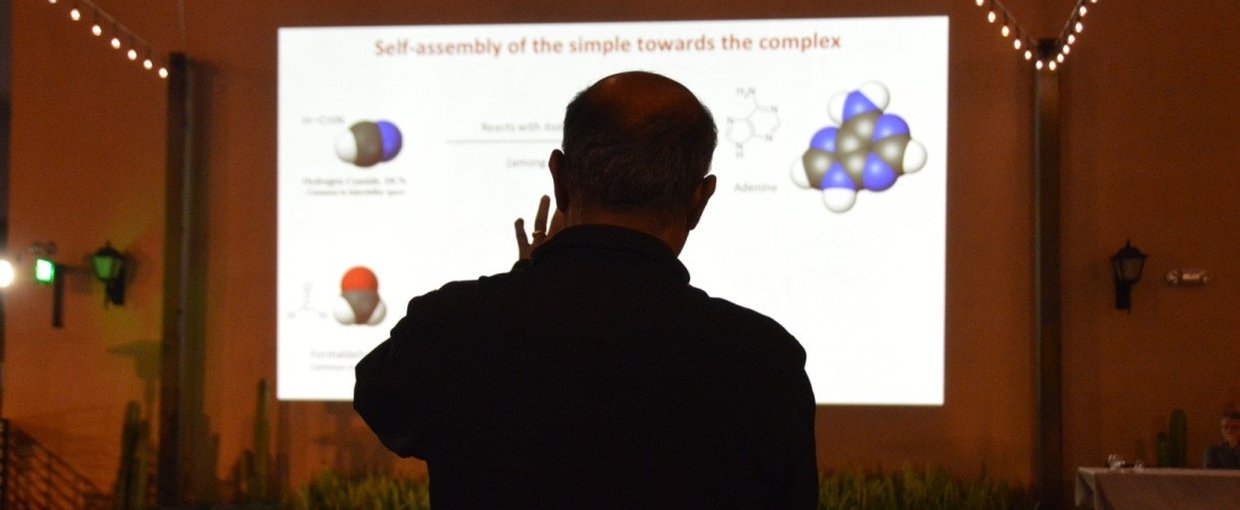
A new study supported in part by the NASA Exobiology Program provides experimental evidence that RNA and DNA could have originated simultaneously and co-existed on the early Earth. The findings have implications for the RNA World hypothesis, and come from a proof-of-concept study published in the journal Nature this week.
Ribonucleic acid (RNA) and deoxyribonucleic acid (DNA) are polymers used by all life today, and are essential for the storage and replication of genetic information. Understanding how these polymers came to exist on Earth is crucial to unraveling the story of life’s origins on our planet.
One of the main origin-of-life theories centers around what is called the ‘RNA World.’ In this scenario, RNA emerges from a mixture of prebiotic chemicals on the early Earth and begins to replicate itself, eventually giving rise to the DNA and proteins. In other words, life began with a homogenous system that it used only RNA (or a similar, ‘pre-RNA’ molecule). This pristine system then gave rise to other molecules and further homogenous systems centered around those molecules, eventually leading to the DNA system we are familiar with today

Professor Ramanarayanan Krishnamurthy speaks at a Story Collider event at the San Diego Festival of Science and Engineering.Image credit: Photos courtesy of Chris Parsons (Center for Chemical Evolution, Georgia Tech).
However, the synthesis of genetic polymers isn’t perfect in nature, and chimeric sequences (molecules that are composed of a mixture of parts, such as those that are part DNA and part RNA) are known to form. Today, sophisticated enzymes are used to correct these ‘mistakes’ in cells, but such enzymes weren’t likely to be available on the early Earth. That raises questions about what would have happened to chimeric sequences at the time of life’s origins.
The new study by researchers at Scripps Research shows that a heterogenous mixture of chimeric molecules could have led to the simultaneous formation of homogeneous strands of RNA and DNA. The experiments began with a mess of small oligonucleotides, some of which have backbones similar to RNA, some with backbones similar to DNA, and some with backbones that are a mix of RNA and DNA.
When chimeras formed they underwent and enabled replication and were eventually sorted out into separate, homologous strands of RNA and DNA. This led to the amplification of both RNA and DNA in the mixture, indicating that hybrid sequences could have played an important role in life’s origins.
As a further test, the researchers also performed experiments using TNA (threose nucleic acid), considered to be a model pre-RNA polymer. The results were similar. TNA-RNA chimeras acted as templates for homogenous strands of TNA and RNA. The study shows that a heterogenous mixture can lead to the simultaneous production of homogenous products, evidence that DNA may not have been the descendent of RNA.

Some of the members of the Krishnamurthy Lab at Scripps Research. From left to right: Subhendu Bhowmik, Ramanarayanan Krishnamurthy, Clémentine Gibard, Kim, Eun-Kyong, Megha Karki. Subhendu Bhowmik, a NASA Post-doctoral Program Fellow, is the lead author of the paper released this week in Nature.Image credit: Scripps.
Future work will step further and further back toward more and more simple starting material.
“Now we are working our way backwards toward the building blocks,” explains co-author Ramanarayanan Krishnamurthy of Scripps Research. “If we start with RNA and DNA nucleotides as mixtures, will they give rise to these chimeric sequences? If that works, we will try to go back further.”
When asked if this work is either ‘narrowing down’ or ‘broadening’ the question of life’s origins, Krishnamurthy explains that the study opens origin-of-life studies up to wider possibilities.
“If we started with a mixture, it is likely that the environmental conditions narrowed it down to what we see today. If you change those environmental conditions, you may end up with a different result.”
The work is focused on understanding the nature of life on Earth, but also bears relevance to NASA’s search for life beyond our planet. If you started with the same basic mixture of materials on another world, where the environment is different than the early Earth, would it lead to the same outcome?
“We can’t expect to see the types of environments we see on Earth today on other worlds,” says Krishnamurthy. “What we are doing is focusing on the extant biology on Earth and trying to extrapolate it backwards. But if you come at this question from the other side, from a systems chemistry or messy chemistry point of view, what would be the outcome if you started from the same mixture but on another planet? For instance, what happens if it’s always -20 C?”
A Community Effort
Krishnamurthy is a member of the NSF-NASA Center for Chemical Evolution (CCE) and a co-lead of Prebiotic Chemistry and Early Earth Environments (PCE3), a Research Coordination Network (RCN) supported by the NASA Astrobiology Program. The goal of PCE3 is to bring together experts from across multiple disciplines to study the origin of life on Earth, and the potential for life to originate on other worlds in the Universe. Work on this publication began before PCE3 was activated, but the results bear relevance to the mission of the RCN.
“I had not initially thought about these results in the PCE3 context, but the network gives us an opportunity to reach out to the community in ways we have not before.”
Origins of life researchers are often described as falling into one of two camps: those who are for and those against the RNA World hypothesis. However, Krishnamurthy describes the response to the new research as enthusiastic, and in some ways freeing. He notes that the results do not rule out the existence of an RNA World at some stage of the process, but they show that life’s origins were not necessarily limited to a homogenous RNA World.
“You’re not trapped in the RNA World,” explains Krishnamurthy. “You don’t have to tie yourself into getting to pure RNA as a starting point. Even if life’s chemistry was messy to begin with, there is the option by this replication to reach homogenous products.”

The Prebiotic Chemistry and Early Earth Environments (PCE3) ConsortiumImage credit: PCE3.
“This replication process could lead to an RNA world, but you could also get DNA,” Krishnamurthy continues. “It says RNA was not the only molecule that played a role, and opens the science up to people who are interested in what could have happened alongside RNA.”
The full press release concerning the Nature publication is available here from Scripps Research.
The paper, “The role of sugar-backbone heterogeneity and chimeras in the simultaneous emergence of RNA and DNA,” was published in Nature Chemistry. The work was supported in part by NASA Astrobiology through the Exobiology Program. This newly-revealed science is also a critical part of NASA’s work to understand the Universe, advance human exploration, and inspire the next generation. As NASA’s Artemis program moves forward with human exploration of the Moon, the search for life on other worlds remains a top priority for the agency.

